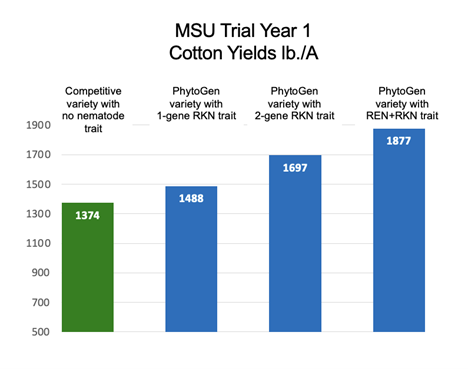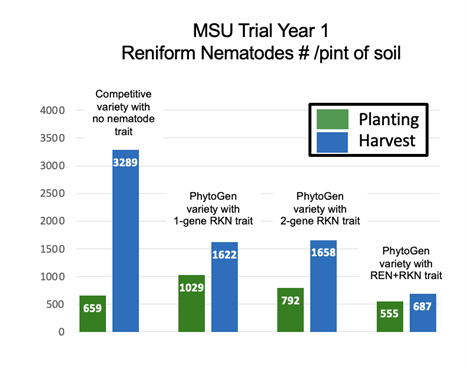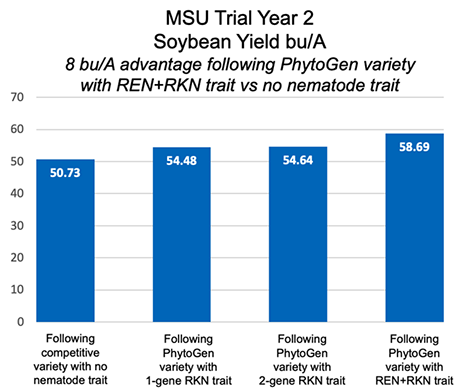New research from Mississippi State University (MSU) suggests planting a PhytoGen® W3FE variety with resistance to both reniform (REN) and root-knot nematodes (RKN) can increase cotton yields by 175 pounds/A up to 502 pounds/A compared to varieties without both nematode traits. The trial was conducted in a field with REN populations that exceeded thresholds.
That’s good news for cotton acres. And the findings are even more promising for Southern farmers who rotate cotton and soybeans. During the following season, soybeans following the PhytoGen variety yielded 8 bu/A more – or 16% greater – than soybeans following cotton varieties without REN and RKN resistance. The research results suggest there may be an opportunity for producers to increase yields in both crops by reducing overall nematode populations through PhytoGen® brand varieties with REN and RKN resistance.
The Problem
REN are a prevalent economic pest on cotton acres, potentially costing growers more than $60 per acre in management expense and yield loss. RKN cost cotton producers another $60 to $70 per acre in most cotton states. Even in moderate populations, REN and RKN can reduce cotton yields enough for economic impact – sometimes without severe symptomology in the field.
While seed treatments and other chemical control measures provide short-term nematode suppression, the best management approach in cotton is to integrate nematode resistant varieties that reduce overall REN and RKN populations.
In soybeans, the negative impact of RKN and soybean cyst nematodes (SCN) are well known by producers, but REN are often overlooked as an economic threat. Many soybean varieties offer native resistance to RKN and SCN, but there are currently no soybeans that offer REN resistance.
The Solution
Growers, agronomists and researchers have wondered if planting a nematode-resistant cotton variety would reduce REN and RKN populations for the following season, thereby improving soybean yield potential.
Research conducted by MSU assistant research professor Tessie Wilkerson, Ph.D., from 2022 to 2024 demonstrated that planting a PhytoGen® brand variety with REN and RKN resistance can significantly increase cotton yields in fields with threshold-level REN populations, compared to a competitive variety without nematode resistance. At the end of the season, REN populations for the competitive variety rose to 3,289 REN/pint of soil. REN populations for the PhytoGen brand variety were only 687 REN/pint of soil.


The next season, eight soybean varieties were planted in the same field. The average soybean yield following the competitive non-resistant variety was 50.73 bu/A. For soybeans planted behind the PhytoGen variety with REN and RKN resistance, the average yield was 58.69 bu/A – or 8 bu/A more. Three of the eight soybean varieties in the study yielded more than 10 bu/A following the PhytoGen brand variety vs. the non-resistant competitive variety.

Key Takeaways
Jonathan Siebert, Ph.D., Corteva Agriscience Agronomy Lead – South Delta and Southwest, says the MSU research confirms what he’s seen in trials and on farms across the Midsouth.
“Reniform nematodes are an often-overlooked pest that can negatively impact yield in both cotton and soybeans,” Siebert said. “By planting PhytoGen brand varieties with reniform and root-knot nematode resistance, growers can reduce nematode populations in the field, increase cotton yields, and improve soybean production the following season.”
One reason REN populations can devastate cotton and soybean yields is because populations can increase in one season. In the MSU research trials, REN populations increased fivefold in one season with a non-resistant cotton variety. RKN-only varieties provided limited benefit against REN, and populations doubled over the season. The only cotton variety that reduced REN populations in the MSU study was the PhytoGen brand variety with REN+RKN resistance.
Siebert said PhytoGen has seen similar results in company trials. Over a three-year period, Siebert gathered soil samples across the Midsouth to measure end-of-season reniform populations for cotton varieties with resistance to REN+RKN and RKN-only. Across more than 35 locations, PhytoGen brand varieties with REN+RKN resistance had a 73% reduction in REN populations compared to RKN-only varieties.
While Siebert believes an integrated pest management approach is always the best practice, he says the MSU research demonstrates that REN and RKN management in a cotton-soybean rotation begins with planting a resistant cotton variety.
“We’ve seen varieties like PHY 411 W3FE take off like wildfire in Mississippi, and a big part of that is the built-in reniform and root-knot resistance that’s increasing cotton yields and reducing nematode populations,” Siebert said. “If you have reniform nematodes and want to increase soybean yields, there’s no seed treatment or chemical control measure that will reduce field populations like planting reniform-resistant PhytoGen varieties the previous season. If you can increase soybean yields by 8 bu/A, you’re basically paying for your soybean seed. That's a game changer.”
™ ® Trademarks of Corteva Agriscience and its affiliated companies ©2025 Corteva. BR (2/25)


